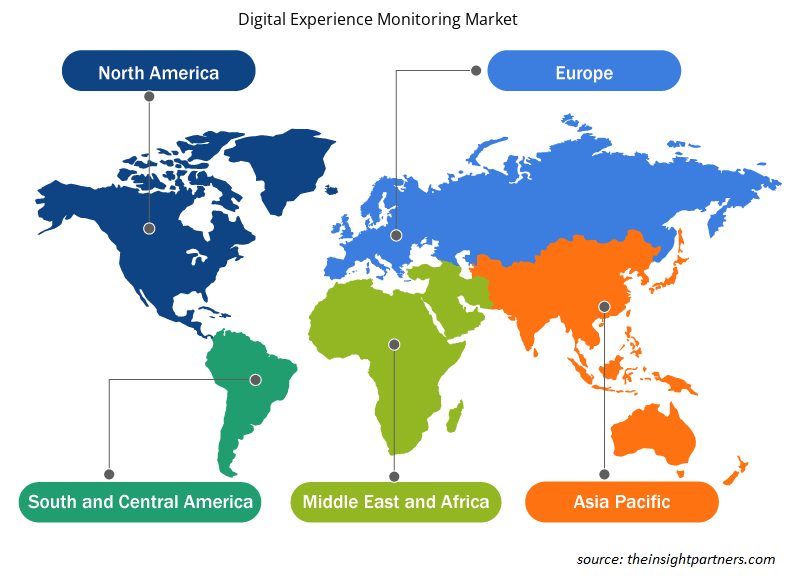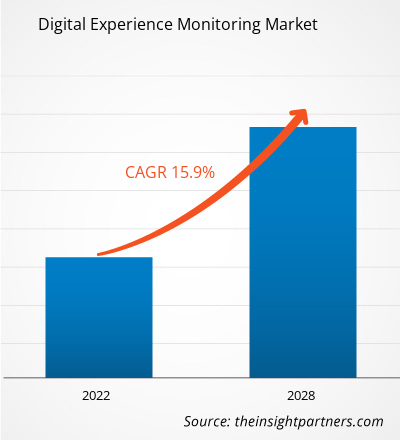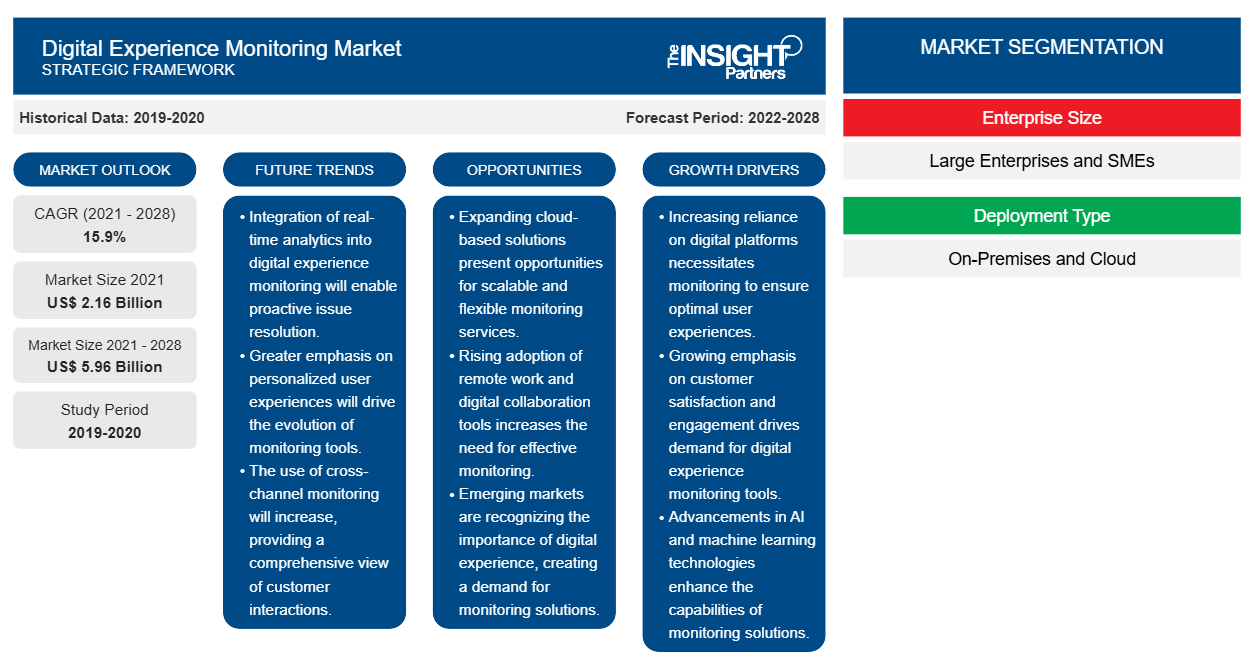Der Markt für Digital Experience Monitoring soll von 2.156,71 Millionen US-Dollar im Jahr 2021 auf 5.960,87 Millionen US-Dollar im Jahr 2028 wachsen. Der Markt für Digital Experience Monitoring soll zwischen 2022 und 2028 mit einer durchschnittlichen jährlichen Wachstumsrate von 15,9 % wachsen.
Digital Experience Monitoring (DEM) ist eine neue Technologie, die Unternehmen als Methode betrachten, um Leistungsprobleme der Benutzer zu vereinfachen und gleichzeitig mit einer einzigen Lösung Einblick in eine Reihe von Netzwerktechnologien zu erhalten. DEM ist die Weiterentwicklung von Application Performance Monitoring ( APM ) und End-User Experience Monitoring ( EUEM ) zu einer ganzheitlichen Lösung, die die Wirksamkeit der Anwendungen und Dienste eines Unternehmens bewertet. DEM ist eine Echtzeitüberwachungslösung, die IT-Betriebsteams dabei unterstützt, Benutzerprobleme umgehend zu lösen und gleichzeitig sicherzustellen, dass das Netzwerk nicht gestört wird. Vorhandene Technologien für Application Performance Monitoring ( APM ) und Network Performance Monitoring and Diagnostics ( NPMD ) können durch DEM-Lösungen ergänzt werden. Wenn sie zusammen verwendet werden, bieten sie eine End-to-End-Ansicht, wobei DEM Einblicke in die Benutzererfahrung bietet. Dies sind die Erfahrungen, die den direktesten Einfluss auf die Unternehmensergebnisse haben. DEM ist ein Echtzeitüberwachungstool, das dazu beiträgt, dass die „Maschine“ Ihres Unternehmens reibungslos funktioniert, indem es Schwachstellen entdeckt, die Ausfallzeiten oder Störungen der Benutzererfahrung verursachen, wie z. B. schlechte Seitenladezeiten, und die zugrunde liegende Ursache der Leistung ermittelt. Die DEM-Software überwacht das Nutzerverhalten, den Datenverkehr und weitere Faktoren, um Unternehmen dabei zu helfen, die Benutzerfreundlichkeit und Leistung des Produkts zu verstehen. DEM-Produkte integrieren aktiven oder simulierten Datenverkehr und die Überwachung realer Benutzer, um die theoretische Leistung und die reale Benutzererfahrung zu analysieren. Diese Tools bieten Analysetools zur Untersuchung und Verbesserung der Anwendungs- und Site-Leistung. Sie helfen Unternehmen auch dabei, zu verstehen, wie Besucher durch ihre Site navigieren, und herauszufinden, wo die Endbenutzererfahrung zu leiden scheint.
Die Untersuchung von Leistungsdaten über Geräte, Apps, Infrastrukturen und Dienste hinweg, um zu verstehen, wie die Interaktionen der Endbenutzer mit der Technologie die Qualität ihrer digitalen Erfahrung beeinflussen, wird als DEM bezeichnet. Die IT kann mithilfe der Überwachung digitaler Erfahrungen verschiedene Parameter verfolgen und bewerten, die sich auf die Benutzer auswirken, darunter CPU, Speicher, Hardwareauslastung, Latenz, Softwareleistung und mehr. Diese Messungen, die ständig vom Endpunkt gesammelt und mit kognitiver Analyse und Automatisierung gepaart werden, können der IT dabei helfen, Probleme ohne das Wissen des Benutzers umgehend zu diagnostizieren, zu beheben und sogar vorherzusagen. Feedback und Meinungen können auch auf Elemente hinweisen, die Endpunktstatistiken nicht erfassen können. Lösungen zur Überwachung digitaler Erfahrungen gehen über die typische Überwachung der Netzwerk- und Anwendungsleistung hinaus und decken Netzwerkprobleme auf, die die Leistung cloudbasierter Dienste beeinträchtigen können. Dieser Faktor beeinflusst das Wachstum des Marktes für die Überwachung digitaler Erfahrungen .
Passen Sie diesen Bericht Ihren Anforderungen an
Sie erhalten kostenlos individuelle Anpassungen an jedem Bericht, einschließlich Teilen dieses Berichts oder einer Analyse auf Länderebene, eines Excel-Datenpakets sowie tolle Angebote und Rabatte für Start-ups und Universitäten.
-
Holen Sie sich die wichtigsten Markttrends aus diesem Bericht.Dieses KOSTENLOSE Beispiel umfasst eine Datenanalyse von Markttrends bis hin zu Schätzungen und Prognosen.
Auswirkungen der COVID-19-Pandemie auf den Markt für Digital Experience Monitoring
Mit dem Ausbruch der COVID-19-Pandemie kam die gesamte Luftfahrtindustrie außerplanmäßig zum Stillstand. Die Türkei, der Iran, Südafrika, der Irak, Israel, Saudi-Arabien und die Vereinigten Arabischen Emirate meldeten eine große Zahl bestätigter COVID-19-Fälle und Todesfälle. Der Markt für digitale Erlebnisüberwachung umfasst große Volkswirtschaften wie die Vereinigten Arabischen Emirate und Saudi-Arabien, die aufgrund der enormen Präsenz eines vielfältigen Kundenstamms potenzielle Anbieter in der Branche der digitalen Erlebnisüberwachung sind. Vor der Pandemie standen die Golfstaaten kurz davor, transformative digitale Technologien in verschiedenen Branchen einzuführen, um die sozioökonomischen Bedingungen der Länder zu verbessern. Aufgrund des COVID-19-Ausbruchs verschärfte die Umsetzung strenger Maßnahmen wie Fabrikschließungen , Geschäftsschließungen und Reisebeschränkungen jedoch die wirtschaftlichen Probleme der Länder wie des MEA . Daher hatten die wirtschaftliche Lage des MEA und die Auswirkungen der COVID-19-Pandemie auf das Wachstum verschiedener Branchen in der Region einen leichten Einfluss auf das Wachstum des Marktes für digitale Erlebnisüberwachung im Jahr 2020.
Markteinblicke zur Überwachung digitaler Erlebnisse
Das Kundenfeedbacksystem, das für jede funktionale und profitable Digital Experience Monitoring-Branche von entscheidender Bedeutung ist, wurde dank technologischer Verbesserungen auf dem Markt für Digital Experience Monitoring verbessert. Unternehmen implementieren beispielsweise ein Online-Feedbacksystem mithilfe eines hochmodernen Customer Relationship Management (CRM). Infolgedessen hilft die Kundeneingabe direkt dabei, Änderungen in Echtzeit vorzunehmen und die Software des Unternehmens zu aktualisieren, um eine Echtzeitbewertung der Qualität durchzuführen und bei Bedarf Anpassungen oder Änderungen vorzunehmen. Jedes Unternehmen, das einen digitalen Übergang erlebt, muss Experience Monitoring-Systeme implementieren. Die Rationalisierung der digitalen Verfahren, die mit der Führung eines Unternehmens verbunden sind, legt eine solide Grundlage für zukünftige Systemänderungen oder kontinuierliche Innovationen. Dies treibt den Markt für Digital Experience Monitoring voran.
Markteinblicke basierend auf der Unternehmensgröße
Marktanalyse für Digital Experience Monitoring nach Unternehmensgröße: Der Markt ist in Großunternehmen und KMU segmentiert. Im Jahr 2021 hatte das Segment der Großunternehmen einen größeren Marktanteil im Bereich Digital Experience Monitoring.
Markteinblicke basierend auf Bereitstellungstypen
Marktanalyse für Digital Experience Monitoring nach Bereitstellungstyp. Der Markt ist in On-Premises und Cloud segmentiert. Im Jahr 2021 hatte das Cloud-Segment einen größeren Marktanteil im Bereich Digital Experience Monitoring.
Die Akteure verfolgen Strategien wie Fusionen, Übernahmen und Marktinitiativen, um ihre Position auf dem Markt zu behaupten. Nachfolgend sind einige Entwicklungen der wichtigsten Marktteilnehmer aufgeführt:
- Im Jahr 2022 kündigte BMC neue Funktionen und Integrationen für seine Portfolios BMC AMI (Automated Mainframe Intelligence) und BMC Compuware an. Die Innovationen helfen Kunden, die Servicequalität zu verbessern und die Softwarebereitstellung zu beschleunigen, indem sie eine bessere Datentransparenz und kontextbasierte Einblicke in ihre IT-Umgebungen bieten.
- Im Jahr 2021 erwarb Broadcom Inc. AppNeta, um die Überwachung der Netzwerkleistung im Internet und in hybriden Cloud-basierten Anwendungen zu verbessern. Durch die Kombination der End-to-End-Transparenz von AppNeta mit den preisgekrönten und bewährten Infrastruktur- und AIOps-Funktionen von Broadcom haben die weltweit größten Unternehmen, die die komplexesten Netzwerke betreiben, nun Zugriff auf eine einzige zuverlässige Informationsquelle, um ihre Cloud-Reise zu unterstützen.
Regionale Einblicke in den Markt für Digital Experience Monitoring
Die regionalen Trends und Faktoren, die den Markt für Digital Experience Monitoring im Prognosezeitraum beeinflussen, wurden von den Analysten von Insight Partners ausführlich erläutert. In diesem Abschnitt werden auch die Marktsegmente und die Geografie des Digital Experience Monitoring in Nordamerika, Europa, im asiatisch-pazifischen Raum, im Nahen Osten und Afrika sowie in Süd- und Mittelamerika erörtert.

- Erhalten Sie regionalspezifische Daten zum Markt für Digital Experience Monitoring
Umfang des Marktberichts zur Überwachung digitaler Erfahrungen
| Berichtsattribut | Details |
|---|---|
| Marktgröße im Jahr 2021 | 2,16 Milliarden US-Dollar |
| Marktgröße bis 2028 | 5,96 Milliarden US-Dollar |
| Globale CAGR (2021 - 2028) | 15,9 % |
| Historische Daten | 2019-2020 |
| Prognosezeitraum | 2022–2028 |
| Abgedeckte Segmente |
Nach Unternehmensgröße
|
| Abgedeckte Regionen und Länder |
Nordamerika
|
| Marktführer und wichtige Unternehmensprofile |
|
Dichte der Marktteilnehmer im Bereich Digital Experience Monitoring: Die Auswirkungen auf die Geschäftsdynamik verstehen
Der Markt für Digital Experience Monitoring wächst rasant, angetrieben durch die steigende Nachfrage der Endnutzer aufgrund von Faktoren wie sich entwickelnden Verbraucherpräferenzen, technologischen Fortschritten und einem größeren Bewusstsein für die Vorteile des Produkts. Mit steigender Nachfrage erweitern Unternehmen ihr Angebot, entwickeln Innovationen, um die Bedürfnisse der Verbraucher zu erfüllen, und nutzen neue Trends, was das Marktwachstum weiter ankurbelt.
Die Marktteilnehmerdichte bezieht sich auf die Verteilung der Firmen oder Unternehmen, die in einem bestimmten Markt oder einer bestimmten Branche tätig sind. Sie gibt an, wie viele Wettbewerber (Marktteilnehmer) in einem bestimmten Marktraum im Verhältnis zu seiner Größe oder seinem gesamten Marktwert präsent sind.
Die wichtigsten Unternehmen auf dem Markt für Digital Experience Monitoring sind:
- AppDynamics LLC
- BMC Software, Inc.
- Broadcom Inc.
- Catchpoint Systems, Inc.
- Dynatrace LLC
Haftungsausschluss : Die oben aufgeführten Unternehmen sind nicht in einer bestimmten Reihenfolge aufgeführt.

- Überblick über die wichtigsten Akteure auf dem Markt für Digital Experience Monitoring
Firmenprofile im Digital Experience Monitoring Market Report
- BMC Software, Inc.
- Broadcom Inc.
- ControlUp Technologies LTD
- Lakeside Software, LLC
- Aternity LLC
- Nexthink SA
- AppDynamics LLC
- Catchpoint Systems, Inc.
- Dynatrace LLC
- IBM Corporation
- Mikrofokus
- Oracle Corporation
- Riverbed Technology, Inc.
- SAP SE
- Historische Analyse (2 Jahre), Basisjahr, Prognose (7 Jahre) mit CAGR
- PEST- und SWOT-Analyse
- Marktgröße Wert/Volumen – Global, Regional, Land
- Branchen- und Wettbewerbslandschaft
- Excel-Datensatz
Aktuelle Berichte
Verwandte Berichte
Erfahrungsberichte
Grund zum Kauf
- Fundierte Entscheidungsfindung
- Marktdynamik verstehen
- Wettbewerbsanalyse
- Kundeneinblicke
- Marktprognosen
- Risikominimierung
- Strategische Planung
- Investitionsbegründung
- Identifizierung neuer Märkte
- Verbesserung von Marketingstrategien
- Steigerung der Betriebseffizienz
- Anpassung an regulatorische Trends























 Kostenlose Probe anfordern für - Markt für Digital Experience Monitoring
Kostenlose Probe anfordern für - Markt für Digital Experience Monitoring